
FSWeekend 2013 is coming again!
As before, I will bring my Motion Cockpit IV for live demo during the complete weekend. You are welcome to take flight.
This year's setup will include:
- Modular cockpit with 5-screen visual
system including fresnell lenses.
- 3DoF motion platform IV, this
time completely powered by BFF motion driver and PID servo card and MD03
motor drivers.
- DIY Force feedback yoke driven by hacked MS Sidewinder and FSForce software
- BFF Shaker system with 3-channel transducer setup. (see below description)
- I'll also bring the first prototype of the balanced linear actuator, to be used in Motion Platform V.
Looking forward to seeing all you fellow simmers, and don't forget to bring your kids! I always love to see those youngsters enjoying a ride in my rig!
Roland van Roy.
----------------------------------------------------------------------------------------------------------------------------------
Standard tactile transducer systems use the flight simulator
audio signal to generate vibrations.
These systems have some limitations:
| They rely entirely on the low frequency content in the aircraft audio files. | |
| Not all aircraft audio files produce useful low frequencies to generate realistic vibrations. | |
| Flight simulator does not produce low frequency cues for touch-down effects, engine start-up/shut-down or turbulence during stall or other events. |
Ian Hopper's BFF Shaker system can improve upon the audio driven vibration systems:
Please have a look at this video
for more explanation of this system. (Updated link, old video got error
message)
BFF Shaker uses information from FSUIPC to generate specific vibrations cues
for various flight simulator events.
The BFF shaker software reads the simulator events, and send signals to the
BFF shaker card, which then generates predetermined waveforms to the
outputs. You can connect motor drivers or audio amplifiers to the BFF Shaker
card.
Connections for DC motor as transducer (via Pololu motor driver)
Connections for traditional tactile transducer via PWM output and audio
amplifier
(In the above setup, you can probably increase the RC time constant 10x
so either use a 10k resistor or 10uF capacitor. This will remove some pulse
artifacts)
The system works quite well, and can provide vibration cues that you cannot
achieve with normal audio driven vibration systems, like engine
start-up/shut-down shudder, very dynamic runway bumps, turbulence effects
during stall, and really neat touch-down effects. (I tested the beta
version)
It does require a good amount of tweaking to get realistic vibrations.
Setting all values at max will generate a clutter of vibrations without
being able to distinguish which cue is giving which vibration effects. So
less is actually better, and the best way to start is to disable all
vibrations and start testing one by one, similar as a motion platform.
Because the BFF Shaker can produce frequencies down to 1Hz, you need vibration transducers that can produce strong vibration at these very low frequencies. Normal flat type transducers are good down to around 15Hz, but the piston type transducers go down to 5Hz or even lower.
You can use a beefy DC motor for generating these very low frequencies: I
used a Ametek 250W motor powered from 24V with pulley and offset crank shaft
mounted to the motor shaft. Below pictures show the basic setup.
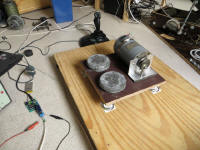
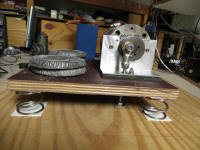
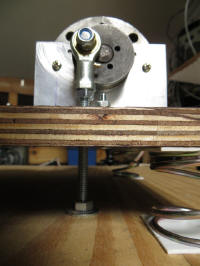
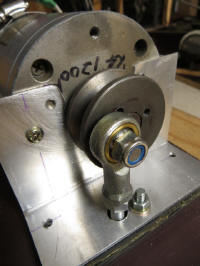
In above setup, the motor will vibrate the floor board in vertical
direction. I found this to give the most realistic vibrations.
I added some lead weights to be motor board, total weight of the vibration
assembly is around 10kg, so this can really move a cockpit floor. Total
power into the motor at peaks: around 100W. I'm sure the motor does not like
to be operated in this way, but so far it seems to hold out well.
It is somewhat less effective in transferring higher frequencies, so I would
advice to complement this system with a normal flat type tactile transducer
(driven via the PWM output)
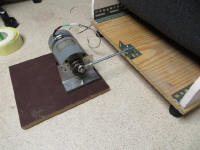
You could also mount the motor as shown in above picture, which will provide
strong longitudinal vibrations. (I found this less realistic)
In all cases, it is important to have the floorboard on flexible rubber
feet:
1. It will increase the effectiveness of the transducer
2. It will avoid transferring the vibrations to your delicate flight
simulator hardware like LCD displays, controls and PC, which would easily be
damaged by violent vibrations.
Overall findings:
| With careful tuning of the vibration parameters (even disabling some turbulence settings) I got a nice set of extra vibrations that can normally not be felt. Touchdown now feels just as good as with a motion platform! | |
| If you don't have a motion platform, then adding vibrations is the next best thing! | |
| Different airplanes really need different settings! | |
| Sometimes the sound files still produce very nice vibrations that the BFF shaker cannot do (ie the slow resonating engine sounds at certain mid rpm), so a combination of various systems probably works best. | |
| The DC motor setup is able to generate strong vibrations, but it is rather big. The piston types like butt-kicker could be used instead and are much more compact. | |
| Engine start-up/shut-down normally give some aircraft shudder in axial (roll) direction. With center mounted transducer, the vertical vibration is not 100% correct here. You could experiment with two transducers, mounted at the sides, driven in opposite phase. |
Oct. 13, 2013 Update:
I got my hand onto some junked
Cryo-Pump units. These
units contain linear motors that can be used as tactile transducer as well.
Below shows a picture of a cryo-pump cut in half. The spring system is high
quality, and allows the unit to be mounted with the piston to the floor
board, and let the mass of complete metal housing with coils vibrate.
Their performance is slightly better than the flat type transducers, but
they cannot make large excursions like the butt-kicker.
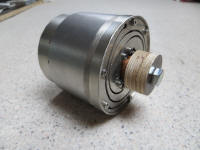

I mounted three of these units to the bottom floor board of my cockpit. This
will transfer the vibrations to the rest of the cockpit, and indeed the
fresnell lenses tend to shake and rattle a bit, but it is OK for now.
When used in combination with the Pololu motor driver cards, these units
still create some switching noise. So I used them in combination with PWM
signal and class B audio amplifiers.
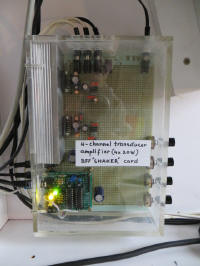
I build a new transducer amplifier: It is the same circuit as described in
the Transducer Amplifier page.
The BFF shaker card is also mounted in the same housing, and is powered from
a 5V regulated supply.
The PWM output of the shaker card is filtered with 1kohm + 10uF RC filter,
and then send to the input low pass filter of the amplifier circuit. The BFF
shaker signal drives two channels of the amplifier (around 20W per channel),
to the two transducers which have 4 ohms impedance each.
The flightsim audio signal is also used, and drives the two other amplifiers
via the same circuit as in Transducer Amplifier
page. I did not need a lot of vibration from the audio signal, so just
connected one transducer to one amplifier output.
The trick to tweak the various signal cues is by first determining which cues need the most vibration: In my case I found that the touchdown needs to be at max level. Next come the runway vibrations. Stall vibration also needs some power, to make sure it is felt above the engine vibration. Engine needs relatively low power, also because you get quite some engine vibs from the audio signal.
The final result is pretty awesome, and I really believe the vibration
system outperforms the motion platform.
I'll demo this new vibration system during FSWeekend 2013. Welcome to try it
out!